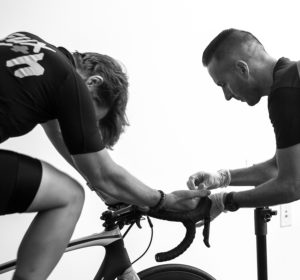VO2 Testing v Lactate Testing
Over the past 22 years I have used both Lactate testing and VO2 testing in the TRIO lab to assess my athletes. In this time I have found that Lactate testing is by far my #1 choice and now consider the VO2 test to be an “added bonus” that is used on rare occasions. Here’s why:
- Lactate is very robust meaning that testing is reliable even given the natural changes in a person’s daily lifestyle. For example, it doesn’t vary if pre-test nutrition is not perfect or if the night before wasn’t the best nights sleep. VO2 testing varies greatly on the time of day, stress level and pre-test nutrition
- The Mask. Many people dislike wearing the face mask when testing especially at high intensity. It often changes their breathing pattern and comfort level since they can’t nose breathe at any stage. Many athletes simply have to rip the mask off as their near peak performance which is far from ideal.
- The standard VO2 protocol requires testing in a fasted state. This in itself is often a stressor for the endurance athlete whose efficient metabolism needs fueling regularly. This stressor is shown in test results and might suggest that the athlete can not burn fats whereas the results are skewed simply by pre-test nutrition.
- Next, the VO2 protocol is very short, taking athletes from zero to max effort in roughly 10-15 minutes. There are many reasons why this doesn’t work to give accurate data especially for training heart rate zones. Firstly, a proper warm-up is not allowed and the pace often feels too fast, too soon for the athlete. Next, heart rate typically takes 2-3 minutes at a set workload to stabilize and become constant. In a VO2 test the pace and/ or incline is alway increasing never allowing an athlete to “settle in to a rhythm” nor for the heart rate to stabilize. It therefore does not give an accurate reading related to the pace/ power and this is a key requirement if you are trying to set accurate training zones. In contrast, the lactate test has a 10-15 minute warm-up then each stage is 4 minutes long allowing the athlete to find their rhythm. The lactate test will typically last at least 40 minutes in most cases.
- The main purpose of testing is to find the way forwards in training. As you can tell from the above statements, I have found that VO2 testing is far less useful than lactate testing for this. The unique “find” that is possible to gauge from a VO2 test is actually a measurement on the athletes Peak VO2 which is essentially, the “size of their engine”. In order to get an accurate # for this, the athlete has to be very well tuned and I have found that most athletes do not achieve Peak VO2 in a test as they are not trained enough or tuned well enough to give an accurate reading. For example, a Ferrari is a Ferrari even if its full of diesel and missing a wheel BUT it won’t test like a Ferrari until its been repaired tuned and properly fueled. Same goes for the human body so ……..
In summary, I use the lactate test to establish heart rate, power and pace training zones and to understand how the athlete is built meaning, how strong their aerobic and anaerobic energy systems are, where their thresholds are and how their biomechanics change with increasing intensity. From here I know exactly how to prescribe training for them so that they can hit their highest level of potential. I occasionally use a VO2 test to check the size of an athletes engine and to gain insight in to the amount of carbs and fats used but only once the athlete is very well trained and has a highly tuned level of fitness to start with.
Book your lactate test with me today. email cg@coachgareth.com



